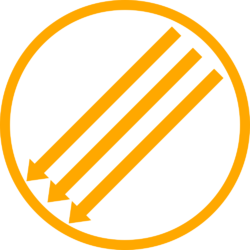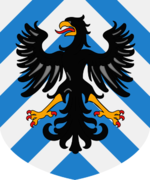Labour Party (Tarper)
| Labour Party Parti Travailliste | |
|---|---|
 | |
| Abbreviation | LP |
| Leader | Reyna Mia Waxweiler |
| Chairperson | Evangeline Aust |
| General Secretary | Tex Kerry |
| Slogan | "Workers of the World, Unite!" |
| Founded | 2004 |
| Split from |
Communist Party of Tarper Socialist Unity Party |
| Newspaper | The Proletariat |
| Student wing | Collegiate Labour |
| Youth wing | Young Labour |
| Membership (January 2017) |
|
| Ideology |
Democratic Socialism Left-wing Populism Multi-tendency |
| Political position | Left-wing |
| National affiliation | Socialist Front |
| International affiliation | none |
| Colors | Orange |
| Bundesrat |
25 / 120 |
| Bundestag |
153 / 709 |
| Party flag | |
 | |
The Labour Party is a Socialist political party in Tarper. The party, led by Reyna Mia Waxweiler since 2013, has become one of the two major contemporary political parties in Tarper, along with the Socialist Unity Party (SU).
Labour has governed at the federal level in Tarper as part of a grand coalition with the SU since December 2013 following the results of the 2013 federal election. Labour participates in 8 state governments, three of them governed by Labour First Ministers.
Contents
History
The party was founded in early 2004 when moderate communists and radical socialists from the CPT and SU, respectively, broke off from their mother parties and created a "Union of True and Angered Socialists", later renamed to the "Labour Party". The name Labour coming from its belief that it is the rightful party to represent the proletariat. The split from the CPT and SU was due to some thinking that having one all-powerful party would lead to a tyranny. The leaders of both factions met the day before and coordinated their move.
Since the party's founding, it has championed one President and a Chancellor. From 2005-2013 the party was the rival of the main Socialist Unity Party, but both parties had actually been quite friendly to one another and soon created the Grand Socialist Coalition after the 2013 federal election. The party has kept its mission of being a stronger and harder socialist party as shown in their voting records. The party continues to be the second largest in the nation.
Possible reunification with the Socialist Unity Party
Labour and the SU have been in a coalition since 2013, and due to the similarities of the two parties, there have been several theories whether the two parties might reunite. The two parties have not commented on this concern, but if it were to happen it would create the largest party in Tarperti history. This would also create a new primary opposition whether from the Greens/GLU, Communists, or Social Democrats.
Party platform
Labour was established as a Revolutionary socialist party in 2005. However, Labour underwent a major shift in policies reflected in the differences between the Anderson Program of 2005, which "called for the transformation of the capitalist system of private ownership of the means of production to social ownership", and the Waxweiler Program of 2013, which aimed to broaden its voter base and move its political position toward that of the SU. After the 2013 Federal Election, under the leadership of Reyna Mia Waxweiler, Labour re-established itself as a less radical socialist party, representing the interests of the working-class and the trade unions.
Internal groupings
Labour is mostly composed of members belonging to either of the three main wings: Moderate communists, radical Democratic socialists, and traditional Marxists. The classical left-wing of Labour claims that in recent years the welfare state has not met the requirements and needs of the post-industrial nation.
Symbols
The party uses the traditional socialist motto of "Workers of the World, Unite!". "La International", the classical socialist anthem serves as the party's official anthem. The cog was chosen due to its connotation to industry and the worker. The party's flag consists of a half occupied by its color of orange and the other half occupied by the color white representing a bright future.
Special organizations
The Labour Party hosts many factions and organizations inside of it.
- Next-Generation Communists (NGC), representing the moderate communist wing;
- Democratic Socialists of Tarper (DST), radical socialists consisting of former SU members;
- Marxists & Labourites (M&L), traditional Marxists;
- Aspiring Labour (AL), youth and student organization;
- LP Publications of Tarper, the group in charge of the newspaper.
Charron Organization
The Charron Organization is the main think tank of the Labour Party. It is named after the late founder of the RUAC, Lyndon Charron, who was killed in a "hunting accident" with the dictator of the Republic of Tarper, Mans Hinder. The organization does political research and goes around teaching Labour socialism.
Base of support
Social structure
The Labour Party fares best among non-Catholic workers as well as intellectuals favoring social progressive causes and increased economic equality. It has become associated with the economic causes of unionized employees and working-class voters. In the 2010's it started taking voters away from the SU in northern states but has started to lose voters and members itself after the 2013 election.
Geographic distribution
Geographically the party does best in the larger cities, Outer Comico, Ostplamyadia, Bergfeld, and Großberg-Südstrand where they are dominant parties, it is a junior partner in the government coalition of Meerland where the CPT rules.
Bundestag election results
| Election | Seats won | ± | Position | Leader |
|---|---|---|---|---|
| 2005 | 180 / 614 |
|
2nd | David Anderson |
| 2009 | 194 / 622 |
|
1st | David Anderson |
| 2013 | 193 / 630 |
|
2nd | Reyna Mia Waxweiler |
| 2017 | 153 / 709 |
|
2nd | Reyna Mia Waxweiler |
Leaders of the Labour Party, 2004-present
| Leader | Period |
|---|---|
| David Anderson | 2004–2013 |
| Reyna Mia Waxweiler | 2013–present |
Tarperti Chancellors from the Labour Party
| Chancellor of Tarper | Time in office |
|---|---|
| David Anderson | 2009–2013 |
Tarperti Presidents from the Labour Party
| President of Tarper | Time in office |
|---|---|
| Jacqueline Fulton | 2009–2013 |
| ||||||||||||||||||||||||||||||||||||||||||

